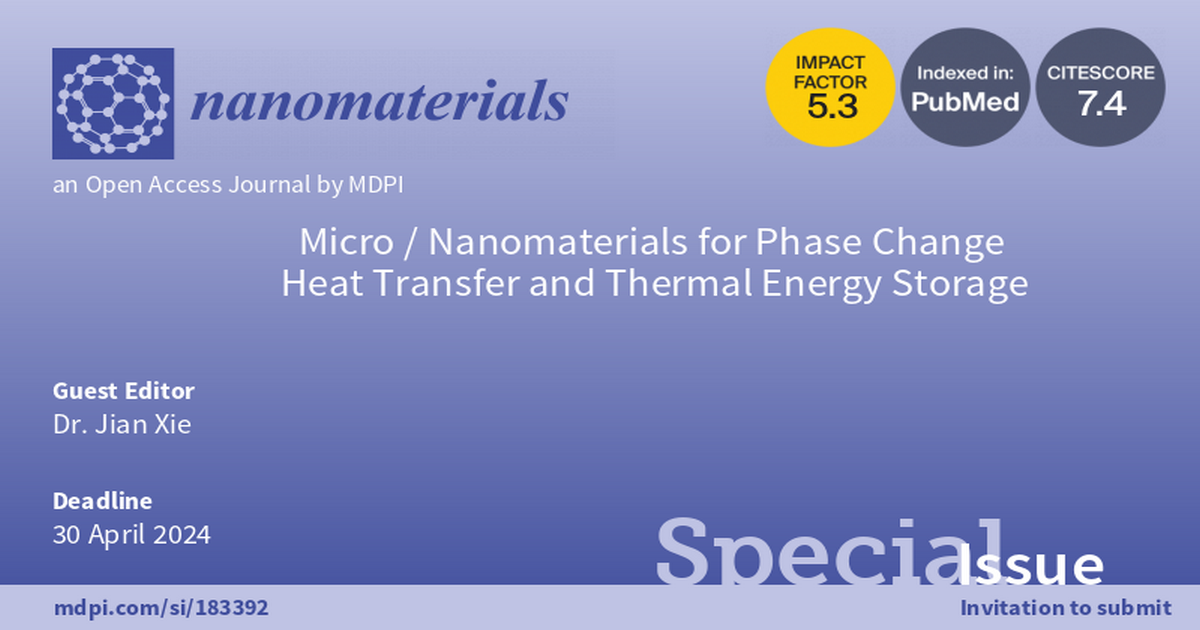Micro/Nanomaterials for Phase Change Heat Transfer and Thermal Energy Storage
A special issue of Nanomaterials (ISSN 2079-4991). This special issue belongs to the section "Energy and Catalysis".
Deadline for manuscript submissions: closed (30 April 2024) | Viewed by 813

Special Issue Editor
Interests: phase change heat transfer on micro/nanostructured surface; supercritical fluids and heat transfer; thermal energy storage with molten-salt
Special Issue Information
Dear Colleagues,
Solid, liquid and gas are the three phases of matter. Different phases have significantly different distance between molecules. The transition from one phase to another is referred to as phase change, which is accompanied by energy supplement or release that changes the distance between molecules. Thus, phase change is an effective way for heat transfer and thermal energy storage. It is widely applied in power generation, desalination, electronics cooling and thermal management. To improve the performance of phase change heat transfer and thermal energy storage, research on different micro/nanomaterials have garnered widespread attention in recent times.
This Special Issue titled ‘Micro/Nanomaterials for Phase Change Heat Transfer and Thermal Energy Storage’ aims to cover investigations of heat transfer and heat storage with functional micro/nanomaterials. We cordially invite researchers to submit their original research papers, communications, and critical reviews related to the following topics:
- Boiling, condensation and freezing on micro/nanostructured surfaces;
- Evaporation and boiling of nanofluids;
- MOF material and micro/nanoparticles for thermal energy storage;
- Heat pipe with porous materials;
- Electronics cooling with microchannel;
- solar-driven desalination with micro/ nanomaterial.
Dr. Jian Xie
Guest Editor
Manuscript Submission Information
Manuscripts should be submitted online at www.mdpi.com by registering and logging in to this website. Once you are registered, click here to go to the submission form. Manuscripts can be submitted until the deadline. All submissions that pass pre-check are peer-reviewed. Accepted papers will be published continuously in the journal (as soon as accepted) and will be listed together on the special issue website. Research articles, review articles as well as short communications are invited. For planned papers, a title and short abstract (about 100 words) can be sent to the Editorial Office for announcement on this website.
Submitted manuscripts should not have been published previously, nor be under consideration for publication elsewhere (except conference proceedings papers). All manuscripts are thoroughly refereed through a single-blind peer-review process. A guide for authors and other relevant information for submission of manuscripts is available on the Instructions for Authors page. Nanomaterials is an international peer-reviewed open access semimonthly journal published by MDPI.
Please visit the Instructions for Authors page before submitting a manuscript. The Article Processing Charge (APC) for publication in this open access journal is 2900 CHF (Swiss Francs). Submitted papers should be well formatted and use good English. Authors may use MDPI's English editing service prior to publication or during author revisions.
Keywords
- condensation
- boiling
- evaporation
- heat transfer
- heat storage
- nanofluid
- micro/nanostructured surface
- nanoparticle
- microchannel
- porous material






